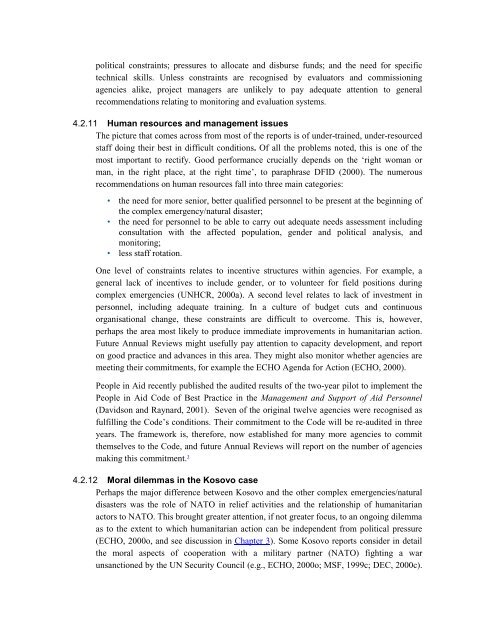Download PDF - ReliefWeb
Download PDF - ReliefWeb
Download PDF - ReliefWeb
You also want an ePaper? Increase the reach of your titles
YUMPU automatically turns print PDFs into web optimized ePapers that Google loves.
political constraints; pressures to allocate and disburse funds; and the need for specific<br />
technical skills. Unless constraints are recognised by evaluators and commissioning<br />
agencies alike, project managers are unlikely to pay adequate attention to general<br />
recommendations relating to monitoring and evaluation systems.<br />
4.2.11 Human resources and management issues<br />
The picture that comes across from most of the reports is of under-trained, under-resourced<br />
staff doing their best in difficult conditions. Of all the problems noted, this is one of the<br />
most important to rectify. Good performance crucially depends on the ‘right woman or<br />
man, in the right place, at the right time’, to paraphrase DFID (2000). The numerous<br />
recommendations on human resources fall into three main categories:<br />
• the need for more senior, better qualified personnel to be present at the beginning of<br />
the complex emergency/natural disaster;<br />
• the need for personnel to be able to carry out adequate needs assessment including<br />
consultation with the affected population, gender and political analysis, and<br />
monitoring;<br />
• less staff rotation.<br />
One level of constraints relates to incentive structures within agencies. For example, a<br />
general lack of incentives to include gender, or to volunteer for field positions during<br />
complex emergencies (UNHCR, 2000a). A second level relates to lack of investment in<br />
personnel, including adequate training. In a culture of budget cuts and continuous<br />
organisational change, these constraints are difficult to overcome. This is, however,<br />
perhaps the area most likely to produce immediate improvements in humanitarian action.<br />
Future Annual Reviews might usefully pay attention to capacity development, and report<br />
on good practice and advances in this area. They might also monitor whether agencies are<br />
meeting their commitments, for example the ECHO Agenda for Action (ECHO, 2000).<br />
People in Aid recently published the audited results of the two-year pilot to implement the<br />
People in Aid Code of Best Practice in the Management and Support of Aid Personnel<br />
(Davidson and Raynard, 2001). Seven of the original twelve agencies were recognised as<br />
fulfilling the Code’s conditions. Their commitment to the Code will be re-audited in three<br />
years. The framework is, therefore, now established for many more agencies to commit<br />
themselves to the Code, and future Annual Reviews will report on the number of agencies<br />
making this commitment. 3<br />
4.2.12 Moral dilemmas in the Kosovo case<br />
Perhaps the major difference between Kosovo and the other complex emergencies/natural<br />
disasters was the role of NATO in relief activities and the relationship of humanitarian<br />
actors to NATO. This brought greater attention, if not greater focus, to an ongoing dilemma<br />
as to the extent to which humanitarian action can be independent from political pressure<br />
(ECHO, 2000o, and see discussion in Chapter 3). Some Kosovo reports consider in detail<br />
the moral aspects of cooperation with a military partner (NATO) fighting a war<br />
unsanctioned by the UN Security Council (e.g., ECHO, 2000o; MSF, 1999c; DEC, 2000c).
















![CynefinFramework final [Read-Only]](https://img.yumpu.com/19017304/1/190x135/cynefinframework-final-read-only.jpg?quality=85)